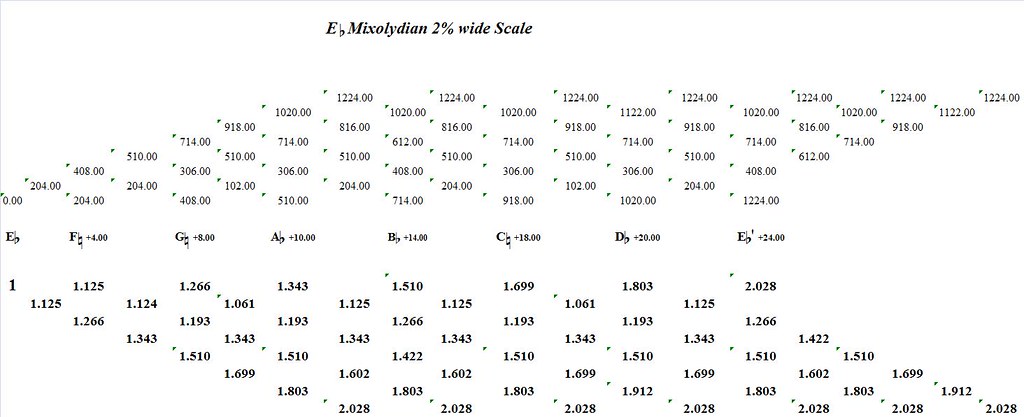
The intervallic content of the E Flat Mixolydian 2% wide Scale.
 Michele Rabbia/Marilyn Crispell/Vincent Courtois: Shifting Grace. 2006. Cam Jazz: CAMJ 7791-2.
Michele Rabbia/Marilyn Crispell/Vincent Courtois: Shifting Grace. 2006. Cam Jazz: CAMJ 7791-2. Derek Bailey/Cyro Baptista: Derek. 2003. Amulet Records: amt 023.
Derek Bailey/Cyro Baptista: Derek. 2003. Amulet Records: amt 023. Gunda Gottschalk: Wassermonde. 2002. Elephant: 002.
Gunda Gottschalk: Wassermonde. 2002. Elephant: 002. Andrew Drury: A Momentary Lapse. 2003. Innova: 581.
Andrew Drury: A Momentary Lapse. 2003. Innova: 581. Bill Frisell/Dave Holland/Elvin Jones: Bill Frisell with Dave Holland and Elvin Jones. 2001. Nonesuch: 79624-2.
Bill Frisell/Dave Holland/Elvin Jones: Bill Frisell with Dave Holland and Elvin Jones. 2001. Nonesuch: 79624-2. The Zs: 4 Systemz: Brown 1951. 2007. Socketscdr: 32.
The Zs: 4 Systemz: Brown 1951. 2007. Socketscdr: 32. The Zs: Arms. 2007. Planaria: PR029.
The Zs: Arms. 2007. Planaria: PR029. Birgit Ulher/Ernst Thoma: Slants. 2003. Unit Records: UTR 4142.
Birgit Ulher/Ernst Thoma: Slants. 2003. Unit Records: UTR 4142. Mark Dresser/Denman Maroney: Time Changes. 2005. Cryptogramophone: CG124.
Mark Dresser/Denman Maroney: Time Changes. 2005. Cryptogramophone: CG124. Albert Ayler: Holy Ghost [disc 4]. 2004. Revenant: 213.
Albert Ayler: Holy Ghost [disc 4]. 2004. Revenant: 213. Iva Bittova/Bang on a Can All-Stars: Elida. 2005. Cantaloupe: CA21027.
Iva Bittova/Bang on a Can All-Stars: Elida. 2005. Cantaloupe: CA21027. Louis Andriessen: De Staat. 1991. Elektra Nonesuch: 9 79251-2.
Louis Andriessen: De Staat. 1991. Elektra Nonesuch: 9 79251-2.
 Harry Partch: Delusion of the Fury A Ritual of Dream and Delusion. 1970 (re-released in 1999). Innova: 406.
Harry Partch: Delusion of the Fury A Ritual of Dream and Delusion. 1970 (re-released in 1999). Innova: 406. Ludwig van Beethoven: The Symphonies (disc 6). Recorded in 1994. The International Music Company: 305299-305.
Ludwig van Beethoven: The Symphonies (disc 6). Recorded in 1994. The International Music Company: 305299-305. Ludwig van Beethoven: The Complete Quartets, Volume V. 1994. Delos: DE 3035.
Ludwig van Beethoven: The Complete Quartets, Volume V. 1994. Delos: DE 3035.String Quartet in E-Flat Major, Op. 74 ("Harfen")
The first movement of the String Quartet in E-Flat Major, Op. 74 is about as definitive an answer to what makes Beethoven such a big deal that these ears have heard. Astonishing feats of thematic development that swims into a soaring moment of transcendent bliss. In many ways, these quartets have more meat than the symphonic cycle. This is partly a result of less exposure. But there is also something about the chamber medium that lends itself to a searing intensity in these polished, middle-period quartets.

 John Berndt/Ben Wright
John Berndt/Ben Wright Bang on a Can Marathon @ Winter Garden, New York, NY
Bang on a Can Marathon @ Winter Garden, New York, NY The centerpiece of this year's marathon was the public debut of SIGNAL performing Steve Reich's Daniel Variations just after midnight. Being deeply familiar with the works of Steve Reich - but not familiar with this piece - it was odd to hear the harmonic patterns and rhythmic propulsion that practically courses through my veins bent into such a strikingly unfamiliar entity. The text juxtaposes the Daniel of the Old Testament with the Jewish reporter Daniel Pearle. Both are memorialized with a sense of reverence somewhere between Desert Music and Different Trains. SIGNAL rendered a rhythmically tight and focused performance. No small feat given the size of this ensemble. Let's hope there are many performance and recording plans for this new titan of new music ensembles.
The centerpiece of this year's marathon was the public debut of SIGNAL performing Steve Reich's Daniel Variations just after midnight. Being deeply familiar with the works of Steve Reich - but not familiar with this piece - it was odd to hear the harmonic patterns and rhythmic propulsion that practically courses through my veins bent into such a strikingly unfamiliar entity. The text juxtaposes the Daniel of the Old Testament with the Jewish reporter Daniel Pearle. Both are memorialized with a sense of reverence somewhere between Desert Music and Different Trains. SIGNAL rendered a rhythmically tight and focused performance. No small feat given the size of this ensemble. Let's hope there are many performance and recording plans for this new titan of new music ensembles. The transition from pounding drums over analog arpeggios into the tranquility of Allison Cameron and Brian Eno required some deft negotiation with a party looking to rage on.
The transition from pounding drums over analog arpeggios into the tranquility of Allison Cameron and Brian Eno required some deft negotiation with a party looking to rage on.